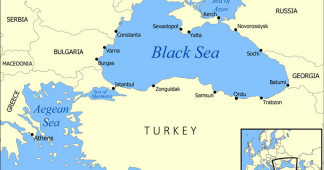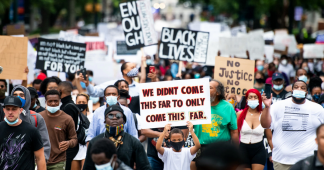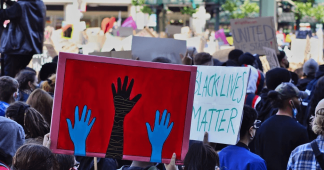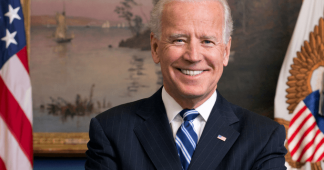June 02, 2021
President Biden traveled to Tulsa, Oklahoma, to mark the 100th anniversary of the 1921 Tulsa race massacre, one of the single greatest acts of racist terrorism in U.S. history. Over a span of 18 hours, a white mob burned down what was known as “Black Wall Street,” the thriving Black neighborhood of Greenwood in Tulsa, and killed an estimated 300 African Americans. Duke University professor William Darity says it’s “very impressive” that a sitting U.S. president highlighted the Tulsa race massacre and its lingering effects, but he says he’s skeptical that Biden’s economic proposals do enough to close the racial wealth gap. “We need something much more potent and much more substantial,” Darity says. “If we were going to bring the share of Black wealth into consistency with the share of the Black population, it would require an expenditure of at least $11 trillion.”
Transcript
AMY GOODMAN: President Biden traveled to Tulsa, Oklahoma, Tuesday to mark the hundredth anniversary of the 1921 Tulsa race massacre, one of the single greatest acts of racist terror in U.S. history. Over a span of 18 hours, a white mob burned down what was known as “Black Wall Street,” the thriving African American neighborhood of Greenwood in Tulsa. An estimated 300 African Americans were killed. On Tuesday, Biden became the first U.S. president to visit the scene of the massacre, where he paid honor to the victims and the few remaining survivors. Biden recounted the horror that took place a hundred years ago.
PRESIDENT JOE BIDEN: And into the morning, the mob terrorized Greenwood, torches and guns, shooting at will. A mob tied a Black man by the waist to the back of their truck, with his head banging along the pavement as they drove off. A murdered Black family draped over the fence of their home outside. An elderly couple knelt by their bed praying to God with their heart and their soul when they were shot in the back of their heads. Private planes — private planes dropping explosives, the first and only domestic aerial assault of its kind on an American city, here in Tulsa. Eight of Greenwood’s nearly two dozen churches burned, like Mt. Zion across the street at Vernon AME. Mother Randle said it was like a war. Mother Fletcher says, all these years later, she still sees Black bodies around. …
One hundred years ago, at this hour, on this first day of June, smoke darkened the Tulsa sky, rising from 35 blocks of Greenwood that were left in ash and ember, razed in rubble. Less than 24 hours — in less than 24 hours, 1,100 Black homes and businesses were lost. Insurance companies — they had insurance, many of them — rejected claims of damage. Ten thousand people were left destitute and homeless, placed in internment camps. As I was told today, they were told, “Don’t you mention you were ever in a camp, or we’ll come and get you.” …
My fellow Americans, this was not a riot. This was a massacre.
AMY GOODMAN: That’s President Biden, speaking in Tulsa, Oklahoma, on Tuesday. Biden was mark the 100th anniversary of the 1921 Tulsa race massacre. He went on to describe how the economic fallout from the massacre is still felt today.
PRESIDENT JOE BIDEN: Imagine a thriving Greenwood in North Tulsa for the last hundred years, what that would have meant for all of Tulsa, including the white community. While the people of Greenwood rebuilt again in the years after the massacre, it didn’t last. Eventually neighborhoods were redlined on maps, locking Black Tulsa out of homeownerships. A highway was built right through the heart of the community.
AMY GOODMAN: President Biden, again, speaking in Tulsa. On Tuesday, the White House also announced measures to narrow the racial wealth gap by addressing housing discrimination and supporting businesses and infrastructure in communities of color.
To talk more about this centennial of the 1921 Tulsa race massacre and the Biden administration’s calls to address the racial wealth gap, we’re joined by William Darity, professor of economics, public policy and African American studies at Duke University, co-author of the book From Here to Equality: Reparations for Black Americans in the Twenty-First Century.
Professor Darity, welcome to Democracy Now! It’s an honor to have you with us. Can you talk about the significance of the president going to Tulsa, acknowledging the race massacre and then talking about closing the racial wealth gap, what that means?
WILLIAM DARITY: I think it’s very impressive that a sitting American president actually took the time and made a very powerful statement by going to Tulsa, Oklahoma, and actually reporting an accurate story about the atrocity that took place there. That, I think, is extremely impressive, and it’s the most important dimension of his visit to Tulsa yesterday.
On the other hand, I’m extremely skeptical about the consequences of the types of proposals that he brought forward for actually addressing the enormous racial wealth gap that exists in the United States today. We need something much more potent and much more substantial than the array of policies that he mentioned yesterday.
JUAN GONZÁLEZ: And, Professor Darity, could you explain why you need something more substantial or why something more substantial is needed? How do the president’s proposals, especially in terms of addressing inequities in home appraisals or contracting or eliminating old Trump-era housing rules — why that’s not sufficient?
WILLIAM DARITY: Well, let me start by saying that we need to be aware of how large the gap is in wealth between Blacks and whites in the United States. The average Black household has a net worth that is $840,000 less than the average white household. A corresponding fact that’s associated with this condition is the Black population of the United States that is descended from persons who were enslaved here is about 12% of the nation’s overall population, but that’s a community that possesses less than 2% of the nation’s wealth. And so, if we were going to bring the share of Black wealth into consistency with the share of the Black population, it would require an expenditure of at least $11 trillion. And so, as a consequence, when we think about any set of policies or any individual policy that is alleged to close the racial wealth gap, we’ve got to ask whether or not it’s going to bring us any way close towards eliminating an $11 trillion deficit. And I’d like to argue that what the president proposed yesterday will do very little in terms of getting us there.
Let me talk specifically about the homeownership emphasis of the policies that he proposed. And I certainly am highly enthusiastic about the idea of eliminating discrimination in home appraisals, but homeownership in and of itself is not something that can be augmented sufficiently to erase the racial wealth difference. I think we have a tendency to overestimate the significance of homeownership alone as a component of an individual’s total array of assets. If we look at the average American’s portfolio, we find that homeownership, specifically ownership in a primary residence, is about 25% of all of the assets that an individual might possess. The other 75% includes business ownership, retirement accounts, financial assets like stocks and bonds, and nonresidential real estate. So if we focus exclusively on homeownership, ownership in a primary residence, we’re going to be ignoring these other components of the asset package. It’s also interesting to note that white non-homeowners — non-homeowners — have 31 times the median wealth of Black non-homeowners. So, homeownership is not the whole package of things. And so, as a consequence, I think we need to have a much wider focus on the full array of assets that people can potentially possess.
And I recommend that the way in which we close the racial wealth gap is by literally closing the racial wealth gap by providing Black American descendants of U.S. slavery with a level of funds that’s adequate to eliminate the racial wealth gap, and to let them make a decision about how to spend those funds in terms of the array of assets that they would like to possess.
JUAN GONZÁLEZ: I wanted to ask you, in terms of reparations — clearly, a decade or two decades ago, that was considered a pipe dream. But could you talk about increasing support among white Americans for reparations? And also, you have mentioned now a couple of times, though, those African Americans descended from slavery. Clearly, there’s a significant proportion of the Black population of the U.S. that has immigrant origins, whether that’s from Jamaica, Barbados, Nigeria, Ethiopia, Sudan, Panama and so forth. So, your view of reparations would specifically deal only with Black Americans descended from slavery. Am I correct in that?
WILLIAM DARITY: Well, I think the term “only” is a bit misleading, insofar as approximately 10% of the current Black population in the United States is from families of recent immigration. Ninety percent of the Black American population consist of individuals who have an ancestor, at least one ancestor, who was enslaved in the United States. And so, that 90% corresponds to approximately 40 million people. So it’s not an “only.” But, indeed, the position that I take is that a reparations plan for African Americans should be specific to those individuals who have ancestors who were enslaved in the United States, because it’s that community that has experienced the cumulative, intergenerational effects of federal policies that have built white wealth to the detriment of Black wealth.
In the book that you mentioned, that Kirsten Mullen and I wrote, From Here to Equality, we actually talk about various phases in American history in which the federal government either actively or passively supported white wealth accumulation while it denied Black Americans the opportunity to accumulate wealth. One of these is what we refer to as the wagon train period, which is the period of homesteading, which occurs coterminous with the Civil War and the end of the Civil War. That’s the period in which Black Americans who had been formerly enslaved were promised 40-acre land grants as restitution for their years of bondage. And that promise was never met. But at the same time, the federal government was providing 160-acre land grants to upwards of one-and-a-half million white families in the Western Territories as the country completed its colonial settler project, and that allocation of land has ramifications for the wealth differential that we observe today. The scholar Trina Williams Shanks has estimated that there are 45 million living white Americans who are beneficiaries of the Homestead Acts. So, that’s the beginning of the racial wealth gap, and it concerns a federal policy that provided essentially land handouts to white Americans while Black Americans, who had been enslaved for multiple generations, received absolutely nothing.
AMY GOODMAN: During a news briefing Tuesday aboard Air Force One, White House Deputy Press Secretary Karine Jean-Pierre was asked if President Biden supports reparations for the families of the victims of the Tulsa massacre.
KARINE JEAN–PIERRE: President Biden believes we have to take core steps right now to fight systemic racism, things like fighting redlining, supporting funding for under schools — underfunded schools, that are too often located in predominantly Black and Brown neighborhoods, and more. He also supports a study, as we’ve said before, into reparations, but believes that, first and foremost, the task in front of us is not to root out — is to root out systemic racism where it exists right now, and that’s why it’s a — central to all of his agenda.
AMY GOODMAN: So, that’s the deputy press secretary. Professor Darity, could you comment specifically about Tulsa? You spoke with National Geographic, which looked at how the savings of a lifetime were reduced to ashes in Tulsa. They even bombed Black Wall Street.
WILLIAM DARITY: Right. The president actually referred to private planes being utilized for the purposes of dropping incendiary devices on the Greenwood District. Actually, these were decommissioned World War II — World War I planes. And so, strictly speaking, they weren’t entirely private planes. And so, once again, the federal government had at least an implicit hand in the Tulsa massacre.
But I think what we have to recognize is that, horrific as the Tulsa massacre was, it was not the only massacre of this type that took place in the United States. In fact, between the end of the Civil War into the 1940s, there were upwards of a hundred of these massacres that took place, North and South, East and West. Tulsa is the one that is most familiar to us now, although it was suppressed as a story for many, many years. But I live in the state of North Carolina, and in 1898 there was a massacre that took place in Wilmington, North Carolina, that was essentially a municipal coup d’état, where comparable numbers of people were killed. And as a consequence, a thriving Black business district that existed in that city also was destroyed.
I would say that across these 100 massacres, the consequences have been palpable in terms of the destruction and appropriation of property that had been accumulated by Black Americans. And in that National Geographic report, to which I was one of the individuals who was a consultant, the estimate has been arrived at that the present value of the property loss to Black Tulsans in 1921 is approximately $610 million.
JUAN GONZÁLEZ: And, Professor Darity, could you talk about examples of reparations that could serve as a model if the country finally did move to reparations for African Americans?
WILLIAM DARITY: Certainly. The most obvious international example, or example external to the United States, is the German reparations payments to victims of the Holocaust. But we have an excellent homegrown example of a reparations plan that involved direct payments to the victimized community: the 1988 Civil Liberties Act, that provided $20,000 payments to each of the Japanese Americans who had been incarcerated unjustly during the course of World War II.
There are other examples, instances in which the United States government was not the culpable party, but still a decision was made to provide restitution. One of these examples is the payments that were made to the families that lost loved ones during the 9/11 terrorist attacks. Another example are the payments that were made to the individuals who had been held hostage in Iran during the Carter-era presidency. Those individuals were held hostage for approximately 440 days. They were given $10,000 per day of captivity. And so, the Iran hostages received up to $4.4 million in payments for their period of captivity.
JUAN GONZÁLEZ: And I asked you earlier, but you didn’t get a chance to respond, about the growth of support for reparations among white Americans?
WILLIAM DARITY: Yeah, thank you. Thanks for bringing that up again, because I didn’t manage to respond to that. Yes, in the year 2000, a survey was conducted by Michael Dawson and Rovana Popoff, who were two faculty members at the University of Chicago. And they found that at that time 4% of white Americans endorsed reparations for Black Americans. If we spring forward to the year 2018, surveys that were taken at that point suggested that the figure was closer to 16% for white American support for reparations — still not a spectacularly high proportion, but much, much better than 4%. And then, the most recent polls that I’m aware of suggest that the proportion has risen somewhere in the vicinity to 30%. And there are indications that a majority of millennials and younger voters in the United States actually endorse reparations, among white Americans, reparations for Black Americans.
AMY GOODMAN: Yesterday you spent hours — the California reparations task force met for the first time. You’re advising them. Can you talk about what they’re looking at in California?
WILLIAM DARITY: Well, the California reparations task force has been charged with examining California’s history of complicity with slavery and complicity with illegal segregation. It’s charged with looking at what types of policies and practices the state of California continues to conduct that inhibit and restrict the lives of its Black American residents. And it’s charged with arriving at a program of remedies. And the first meeting yesterday was essentially the launch of the task force’s activity. And it will be very, very interesting, and perhaps precedent-setting, to see what the task force ultimately decides to do in its report that it presents to the California Legislature.
AMY GOODMAN: Professor Darity, before we end, I wanted to ask you about the backlash growing after the University of North Carolina at Chapel Hill, nearby you at Duke, denied tenure to the Pulitzer Prize-winning journalist Nikole Hannah-Jones, best known for producing The 1619 Project with The New York Times, an interactive project which reexamines the legacy of slavery. Can you talk about what this means, the denial of tenure, and why you care so much about this issue?
WILLIAM DARITY: I would like to cast this in the context of a wider attempt to censor the development and advancement of an accurate story of America’s history with respect to racial injustice. Race is so heavily infused in America’s story that to remove race and racism from the conversation, as many, many legislators around the country are attempting to do in this moment, I would suggest that that’s actually a deep tragedy, and it’s a consequence of the failure of the country to do something that Kirsten Mullen and I refer to as “deconfederatize.” That is to say, if we think about the aftermath of World War II in Germany, there are many complaints that we can raise about what the German population did, but one thing that they did not do is create an atmosphere of celebration and triumph about the Nazis. In the United States, in contrast, the losers of the Civil War have actually crafted the story of this nation’s history. And this is a consequence of the direct actions of organizations like the United Daughters of the Confederacy and the Daughters of the American Revolution. And as a consequence, we have been taught a lie for most of our lives.
And so, I see the attempt to constrain the appointment of Nikole Hannah-Jones as part and parcel of a wider effort to maintain a dishonest story about America’s past. We have to undergo a deconfederatization, that has not taken place for 155 years. It’s time for that to happen. It’s time for us to ensure that we tell the truth about America’s past, including the truth about episodes of horrific violence, like what took place in Tulsa, Oklahoma, in 1921.
AMY GOODMAN: William Darity, we thank you so much for being with us, professor of economics, public policy and African American studies at Duke University, co-author of the book From Here to Equality: Reparations for Black Americans in the Twenty-First Century.
Published at www.democracynow.org











